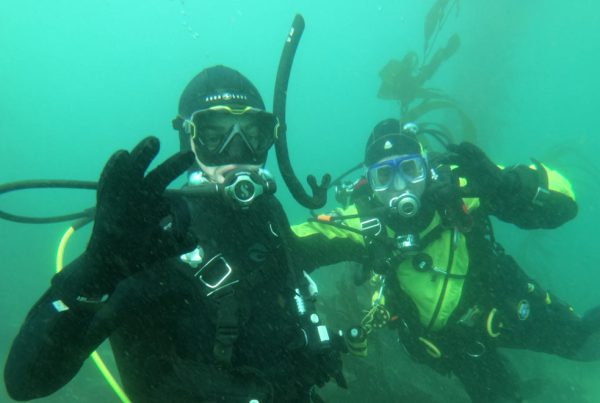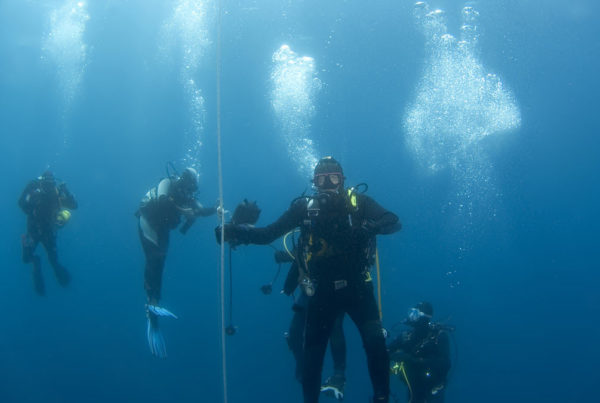Knowing how to dive in currents is an important skill and should be taught in any basic scuba class. The most basic principle of current diving is to start your dive heading up current, returning with the current. Another important principle of current diving is the use of a trailing line with a float for use should you overshoot the boat.
But these are just basic techniques for standard current diving. The ocean can get trickier than that.
THE EDDY
Eddies often occur inside of coves or points with strong currents occurring on the outside. The current is diverted inside the cove forming a swirling or counter current that can be confusing at best. The current close to shore could be completely opposite of the current just offshore.
In any situation when strong currents exist near a cove you are diving, study the water movement carefully. Look for the lay of the kelp or movement of debris in the water. If a counter current is detected, careful dive planing is in order. The nearshore current is weaker and easier to deal with. The outer current is usually too strong and best avoided.
LONGSHORE CURRENT
Longshore current, a frequently misused term, refers to the net water movement close to shore due to waves hitting a beach at an angle. Simply put, the waves push the water down the beach. Because it is a result of wave action, it occurs only in the surf zone and just a bit beyond. It only becomes a real issue on beach dives off of long sand beaches. It mucks up dive plans in navigating across the surf zone to a specific dive spot beyond the surf. If the longshore current drift is not taken into consideration, a dive site could be missed on the swim out.
RIP CURRENTS
As waves push upon to a beach, the water flows back to the sea following the path of least resistance, usually back under the wave in an action commonly called “undertow.” But sometimes the water flows first sideways then back in shallow troughs in the beach. Also, sometimes longshore currents running in opposite directions converge and the water again flows out to sea in shallow troughs. Both instances form a “rip current” with the latter generally being stronger. Rip currents can range in strength from barely a tug to a pull of 4 to 5 knots in strength. Because these currents are born in the surf zone, they carry dirty plumes of water far offshore. It is these dirty plumes that are the best evidence of an ongoing rip. There is also a reduced surf action in rip.
Most deep coves have a prevailing rip. Because waves curve to the shape of shore, longshore currents form along the sides of the cove, pushing toward the center of the cove. The net water movement then moves out the center of the cove.
Rips are both a blessing and curse to beach divers. While they can provide a quick and easy ride out to a dive site, they can also cloud the water over that site. They can also make returning to the beach difficult.
UNDERTOW
To the uninitiated, beach diving can be intimidating. Small to moderate surf, however, can be easily overcome with the proper surf entry techniques. Key is using the water flow on a beach to your advantage. Waves push water up on a beach, but there is also a flow back to sea. This is generally in the form of undertow.
As you move out through the surf zone, you may find the incoming waves a bit overpowering in addition to the disconcerting tug at your ankles of the undertow. As soon as the water is as little as knee-deep, get low in the water with your regulator in your mouth. As a wave comes in, duck under. Not only will you avoid the incoming surge, the undertow will take you out with considerably less effort.
SURGE
While not truly a current, surge from wave action is probably the most common water movement divers encounter. Its effect is most pronounced in the shallows but can be accentuated by reef shape.
While surge can be quite frightening with its victim feeling quite out of control, it is easy to overcome, even enjoy. First, relax and go with the flow. Don’t fight the overwhelming power of the sea as you will simply exhaust yourself. Water seeks the path of least resistance. If you relax and flow with the water it is highly unlikely you will be slammed into a rock (even so, it won’t hurt to get your hands out in front of your face if you think you might be headed for an intimate encounter with the reef).
A more prevalent danger from heavy surge is a bubble “white-out.” If shallow, and near a frothy surge area, it is possible to get into a situation with a lot of bubbles in the water, reducing visibility to zero. Again, relax and wait for the bubbles to clear which usually only takes a few moments.
Downcurrent
Downcurrents are very rare but dangerous. Although not entirely understood, they generally occur when a strong current rakes across the flat bottom that ends in a sharp vertical drop off. The current then drops down the face of the wall. They can push a diver downward forcefully and unexpectedly. Fortunately, downcurrents are a localized phenomenon. If not in immediate danger, hug the wall and ascend, climbing the wall if necessary. You can also try moving along the wall in one direction or another.
Another alternative is to swim away from the wall and hopefully out of the downcurrent. If all else fails, and only in the most extreme circumstances (i.e. extreme depth and/or out of air), ditch your lead and/or inflate your BC but be very careful of an uncontrolled ascent once clear of the downcurrent.









